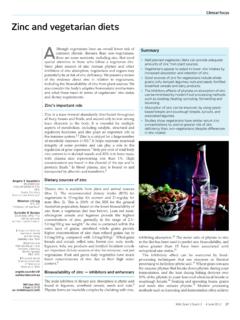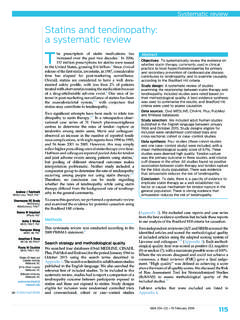Transcription of Diagnostic triage for low back pain: a practical approach ...
1 Narrative review Diagnostic triage for low back pain: a practical approach for primary care Lynn D Bardin1,2, Peter King3, Chris G Maher4. O. ne in seven Australians ( ) will suffer from back pain Summary on any day,1 which makes this condition the largest Diagnostic triage is an essential guideline recommendation contributor to the burden of disease in Australia, accord- for low back pain (LBP), which is the most frequent ing to the Global Burden of Disease In Australia, low back musculoskeletal condition that general practitioners pain (LBP) is the most common musculoskeletal condition for encounter in Australia. Clinical diagnosis of LBP informed which patients consult general Back problems are by a focused history and clinical examination is the key more common in older people, and with an ageing Australian initial step for GPs, and determines subsequent Diagnostic population, the million GP encounters for LBP in 2012e20131 workup and allied health and medical specialist referral.
2 Are likely to escalate. Given this context, GPs need a practical The goal of Diagnostic triage of LBP is to exclude non-spinal approach to assess and treat their patients with LBP. causes and to allocate patients to one of three broad cate- gories: speci c spinal pathology (< 1% of cases), radicular A key step in the primary care management of LBP involves a syndrome (w 5e10% of cases) or non-speci c LBP (NSLBP), Diagnostic triage that classi es patients into three broad categories which represents 90e95% of cases and is diagnosed by (Box 1). Based on a focused clinical assessment, patients are clas- exclusion of the rst two categories. For speci c spinal si ed as having a speci c spinal pathology (< 1%), radicular syn- pathologies (eg, vertebral fracture, malignancy, infection, axial drome3 (ie, nerve root pathology including spinal canal stenosis; spondyloarthritis or cauda equina syndrome), a clinical w 5e10%), and non-speci c LBP ([NSLBP]; 90e95%).
3 The triage assessment may reveal the key alerting features. For radicular syndrome, clinical features distinguish three subsets of nerve approach informs decisions about the need for further Diagnostic root involvement: radicular pain, radiculopathy and spinal workup (eg, imaging or laboratory tests), guides the care the GP. stenosis. needs to provide and helps the GP identify the patients who require Differential diagnosis of back-related leg pain is complex and referral to allied health or medical clinical manifestations are highly variable. However, distinctive This article aims to outline the Diagnostic triage approach in greater clusters of characteristic history cues and positive clinical detail than that found in clinical practice guidelines,3-5 and to show examination signs, particularly from neurological examination, guide differential diagnosis within this triage category.
4 The clinical utility of the approach for the primary care manage- A diagnosis of NSLBP presumes exclusion of speci c ment of LBP. We identi ed relevant current English language pathologies and nerve root involvement. A biopsychosocial clinical guidelines and publications from the Cochrane Library and model of care underpins NSLBP; this includes managing pain PubMed in February 2016, our existing records, and citation intensity and considering risk for disability, which directs tracking. We used search terms for LBP and key concepts in our matched pathways of care . article (eg, differential diagnosis, low back pain, sciatica and spinal Back pain is a symptom and not a diagnosis. Careful stenosis). Diagnostic differentiation is required and, in primary care , Diagnostic triage of LBP is the anchor for a diagnosis.
5 Diagnostic triage for primary care management of low back pain clinicians identify patients with a higher probability of speci c The goal of the Diagnostic triage for LBP is to exclude non-spinal pathology, who require further Diagnostic workup to allow a causes of LBP and to allocate patients to one of three categories de nitive diagnosis. While there are scores of red ags endorsed in that subsequently direct management (Box 1). A focused history and texts and guidelines, many are of limited or no value. A good a physical examination of the patient form the cornerstone to the illustration is the red ag thoracic pain , which has both a positive Diagnostic triage classi cation; moreover, diagnosis of the largest and negative likelihood ratio of (for cancer), meaning that both NSLBP group is by exclusion of the other two categories (Box 1).
6 A positive and negative test result are Based on two recent Cochrane reviews, only a small subset of red ags (ie, older We describe the approach endorsed in the latest clinical practice age, prolonged corticosteroid use, severe trauma and presence of a guidelines and suggest some updates based on research published contusion or abrasion) are informative for detection of fracture, and subsequent to the guidelines. Limited but essential background in- a history of malignancy is the only red ag increasing the likelihood formation is provided for stepwise application of the Diagnostic of spinal 3 April 2017. triage . For patients with suspected speci c spinal pathology, the condi- tion itself dictates the next steps the GP should take (Box 2). Speci c spinal pathology Patients with rapidly deteriorating neurological status or a pre- j MJA 206 (6).
7 The initial step is to recognise that in primary care , LBP is occa- sentation suggesting cauda equina syndrome require urgent sionally the initial symptom of a number of more serious speci c (same day) referral to a neurosurgeon. Where there is suspicion spinal pathologies (Box 1), the most common of which is vertebral of infection (such as a spinal epidural abscess that may have fracture (Box 2). A range of clinical features or red ags (eg, age important medico-legal implications if missed) or strong suspicion > 50 years or presence of night pain) have been proposed to help of cancer or fracture, the GP should initiate further Diagnostic 268 1. Austin Health, Melbourne, VIC. 2 SuperSpine, Melbourne, VIC. 3. King St Medical Centre, Melbourne, VIC. 4. George Institute for Global Health, Sydney, NSW.
8 J doi: Narrative review Radicular pain: in primary care , LBP-related leg pain is com- 1 Diagnostic triage for low back pain (LBP). mon with about 60% of patients with LBP reporting pain in the legs;31 however, the subgroup with true radicular pain is much smaller. A prospective cohort study of radicular pain in the Dutch general practice 10-year follow-up20 found that the mean incidence was episodes per 1000 person-years. Radicular, neurogenic leg pain, for which there is no gold standard diag- nosis,18 is distinct from and more debilitating than somatic referred leg pain, and is associated with greater GP consulta- tions,18 functional limitations, work disability, anxiety, depression and reduced quality of life,32 as well as imaging and surgical health care costs. Cues about the severity, asymmetry and radiating quality of leg pain from the history (Box 3) sug- gest radicular pain; however, speci c dermatomal-dominant pain location has the greatest single-item Diagnostic val- Positive nerve tension tests for upper lumbar roots (prone knee bend) or lower roots (straight leg raise and crossed straight leg raise) are common physical examination signs that guide Radiculopathy: caused by nerve root dysfunction and de ned by dermatomal sensory disturbances, weakness of muscles innervated by that nerve root and hypoactive muscle stretch re ex of the same nerve root,22 frequently co-exists with radicular pain.
9 However, a patient with L4 radiculopathy may present with footdrop which is a severely compromised or absent concentric foot dorsi exion due to marked weakness of the tibialis anterior muscle, the strongest dorsi exor of the foot GP general practitioner. * For Diagnostic features, see Box 2. y For Diagnostic or paraesthesia without radicular pain, suggesting that the features, see Box 3. z Diagnosis by exclusion of the rst two categories. u two are separate Diagnostic entities. A single positive symp- tom or sign of sensory (soft) or motor (hard) de cit con rms workup to con rm the diagnosis. When there is less convincing the diagnosis (Box 3); nevertheless, myotomal weakness is the evidence of cancer or fracture, a trial of therapy with review in most Diagnostic hard 1e2 weeks may be considered.
10 In the same way, watchful waiting Spinal stenosis: both degenerative in older patients and ac- and a trial of therapy may be appropriate for suspected axial quired or congenital in younger patients. Spinal stenosis has spondyloarthritis (axSpA). However, axSpA is often missed, with key clinical features such as neurogenic claudication34 relieved most patients typically diagnosed many years after the initial in forward exion or sitting15,35 (Box 3). Neurological exami- symptoms; therefore, scheduling a review is crucial to avoid this nation is often normal36 in contrast to radicular pain or problem. Guidelines for rheumatology referral of axSpA are radiculopathy. summarised in Box 2, together with the prevalence, alerting fea- tures (ie, risk factors), Diagnostic workup and tertiary referral Recent research shows a favourable prognosis for all three pathways for each of the speci c spinal pathologies.










